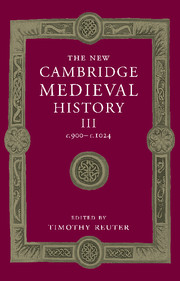Book contents
- Frontmatter
- 1 Introduction: reading the tenth century
- PART I GENERAL THEMES
- 2 Rural economy and country life
- 3 Merchants, markets and towns
- 4 Rulers and government
- 5 The Church
- 6 Monasticism: the first wave of reform
- 7 Intellectual life
- 8 Artists and patrons
- PART II POST-CAROLINGIAN EUROPE
- PART III NON-CAROLINGIAN EUROPE
- Appendix genealogical tables
- List of primary sources
- Bibliography of secondary works arranged by chapter
- Index
- Frontispiece
- Plate section
- Map 2: Archbishoprics and bishoprics in the early eleventh century
- Map 4: Germany
- Map 13: Byzantium in 1025
- References
5 - The Church
from PART I - GENERAL THEMES
Published online by Cambridge University Press: 28 March 2008
- Frontmatter
- 1 Introduction: reading the tenth century
- PART I GENERAL THEMES
- 2 Rural economy and country life
- 3 Merchants, markets and towns
- 4 Rulers and government
- 5 The Church
- 6 Monasticism: the first wave of reform
- 7 Intellectual life
- 8 Artists and patrons
- PART II POST-CAROLINGIAN EUROPE
- PART III NON-CAROLINGIAN EUROPE
- Appendix genealogical tables
- List of primary sources
- Bibliography of secondary works arranged by chapter
- Index
- Frontispiece
- Plate section
- Map 2: Archbishoprics and bishoprics in the early eleventh century
- Map 4: Germany
- Map 13: Byzantium in 1025
- References
Summary
the history of the church in Europe in the tenth and early eleventh centuries is essentially the history of many local churches, in which the dominant role in secular ecclesiastical and religious life was played by the bishops. Only occasionally can large-scale collective activity be observed; for the most part the very different challenges to religion from within and without the Christian world and the responses to them on the part of various members of the ecclesiastical hierarchy in western Europe mean that it is above all local preoccupations and regional differences that are reflected in the surviving evidence. Nevertheless, the evidence taken as a whole, that is, the synodal legislation and canon law collections, lives of bishops, histories of sees and monasteries, liturgy, music, accounts of saints’ cults, books containing patristic and Carolingian theology and biblical exegesis produced for use within ecclesiastical institutions, theological treatises, polemical pièces d’occasions and incidental references in the narrative histories of the period, reveals not only lines of continuity with the ninth-century Carolingian church but also many elements of coherence and unity within the remarkable diversity of the tenth-century church. Not all of this coherence can be attributed to the links with monasticism and monks throughout western Europe on the part of the secular clergy, though the zeal for monastic reform undoubtedly was a common bond right across Europe. The evidence itself, moreover, presents particular problems of interpretation, for much of it was designed to present ideals and norms, whether of saints’ and bishops’ behaviour, of what was expected of the laity in the Christian observance, or of the interaction between the clergy and the laity, which do not necessarily provide a faithful reflection of reality.
Keywords
- Type
- Chapter
- Information
- The New Cambridge Medieval History , pp. 130 - 162Publisher: Cambridge University PressPrint publication year: 2000
References
- 5
- Cited by

